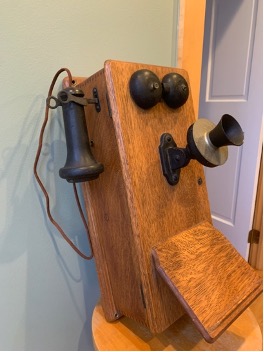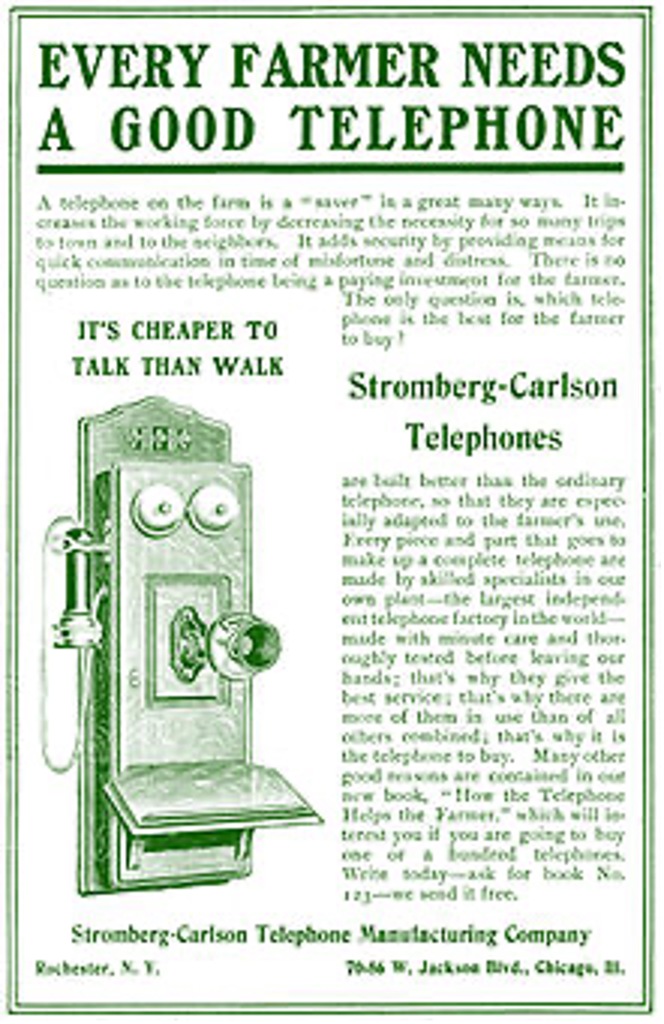Crank telephone, 1918, Rochester New York, red oak, metal, 18/ 8 x 6 inches, Personal Collection, Cooperstown NY, Photograph by Cole Webster.
The telegraph was the first commercial telecommunication system. Invented in the 1840’s, the telegraph was used primarily by post offices, railway stations, and government centers1. The telegraph was limited in that it used Morse code, a language of dots and dashes, and only one message could be sent or received at a time. Working to improve the telegraph and break the monopoly of the Western Union Telegraph Company, Alexander Graham Bell experimented with the “harmonic telegraph” based on the principal that musical notes of different pitches could be sent down a wire simultaneously. From his experiments with adding multiple signals to a wire, Bell explored the possibility of transmitting the human voice electrically. Bell was the first to patent this “telephony” technology in 1876, and the Bell Telephone Company was manufacturing and leasing telephones by 18772.
When Bell’s patent expired in 1894, hundreds of companies began building and installing telephones all over the country. The Stromberg-Carlson Telephone Manufacturing Company emerged as a leader by marketing the telephone as the “farmer’s friend”3. In a 1905 advertising brochure, “How the Telephone Helps the Farmer” the company suggested that the telephone “saved working time by decreasing the necessity for so many trips to town or to the neighbors” and “added security by providing means for quick communication in times of misfortune or distress”4. Within years, the telephone became an indispensable tool in connecting small towns and rural communities.
This piece is a Stromberg-Carlson wall mounted crank phone (model number 1918) manufactured in Rochester, New York. This telephone is from my great-great grandmother, Mary Davis Webster’s, home in Greenwood, New York. It was installed after her husband’s death, to alleviate her isolation on the family farm by connecting her with neighbors and her son, George Webster, in Ohio. The phone measures 19-inches long, 9-inches wide, and 6-inches deep. The front of the oak cabinet has two bells, the mouthpiece, and a sloped writing shelf. The earpiece or receiver hangs on a two-prong hook on the left, and the crank mechanism is on the right side. The cabinet houses the electrical generator which powers the telephone. To make a call Mary would lift the receiver off the hook and turn the crank on the right to alert the operator. If the operator’s phone was in use, the handle was hard to turn and she would have to try again later. When the operator answered, Mary would speak into the mouthpiece and ask the operator to connect the call. The operator would make the local connection or call subsequent exchanges for a longer distance call. At the end of the call, Mary would replace the receiver on the hook and turn the crank to notify the operator that the call could be disconnected.
Telephone technology revolutionized communication. It allowed people to connect with one another through conversations in real time. By the turn of the century, the telephone enabled this type of communication for ordinary citizens. The telephone effectively connected people and businesses the across the country and the eventually around the world.
1 History.com Editors (2009) Morse Code & The Telegraph, History.com. A&E Television Networks. Available at: https://www.history.com/topics/inventions/telegraph (Accessed: November 20, 2022).
2History of the telephone (no date) National ITPA. Available at: https://www.nationalitpa.com/history-of-telephone (Accessed: November 20, 2022).
3 Stromberg-Carlson (2022) Wikipedia. Wikimedia Foundation. Available at: https://en.wikipedia.org/wiki/Stromberg-Carlson (Accessed: November 20, 2022)
4 Ryan, J. (no date) How The Telephone Helps The Farmer , TCI Library – Home. Available at: https://www.telephonecollectors.info/strombergcarlson/ (Accessed: November 20, 2022).
5 Stromberg-Carlson Telephone (2021) Western Illinois Museum. Available at: https://www.wimuseum.org/stromberg-carlson-telephone/ (Accessed: November 20, 2022).

